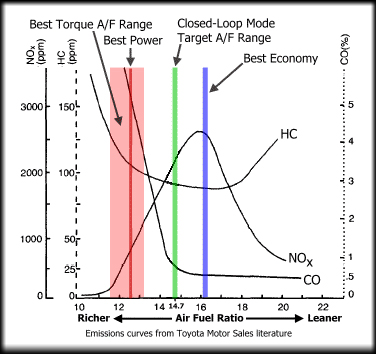OK so the cycling bit:
With a narrow band, they are normally set at 14.7:1 as the changeover point. Some are not - the furthest from this mark that I've found are mid-late '90's Range Rovers, which have the change over point at 12.3:1.
That is all beside the point. What is important is the cycling from rich to lean. A Narrow Band sensor is so called because it changes voltage over a very narrow band at the change over point, from 0-5V, hence all it is doing is saying to the ECU "Too rich, make it leaner" or "too lean, make it richer". Therefore every time the O2 sensor takes a reading (roughly every 4 cycles / 8 revs I've been told, depending on revs) it will then make an adjustment to the fueling.
So, lets pretend you're really lean. 4 cycles go by, the O2 sensors reads that it is still too lean, so it puts a few more points of fuel in. Next O2 sensor cycle it makes another adjustment, and then overshoots. You're now running too rich. So then it makes another adjustment, and you're too lean.
These adjustments aren't much, but they are designed to keep you at 14.7:1 because this is where the lowest of all three measured emissions are. A 5 gas test looks for CO2, CO, THC (Total Hydro Carbons, measured in free hexane), O2 and NOx. I've got one home here, and I use it on my customers cars as well as for basic setup of my own stuff before I head out on the road for the first time with a new tune.
Here's a picture that I've put on a few different forums (normally linked from wherever google shows me first). It's from Toyota, and it's accurate for getting the idea across that rich or lean is bad when it comes to emissions. You need 14.7:1 as this is where the total of the 3 polluting gas components (THC, NOx and CO) are the lowest in total.

The cycling from rich to lean is necessary for the cat to replenish O2 to be able to 'burn' the fuel completely, hence converting the CO to CO2, removing more of the THCs and converting the NOx molecules (not 100% of the chemistry of what they get turned into).
Does this help? I've put heaps more info on OzClubbies (and there is even more information from a handful of guys who have either made extraordinary amounts of notes from their IM240 testing in Vic or from their works as emissions engineers working for Holden.
Cheers,
Treeve